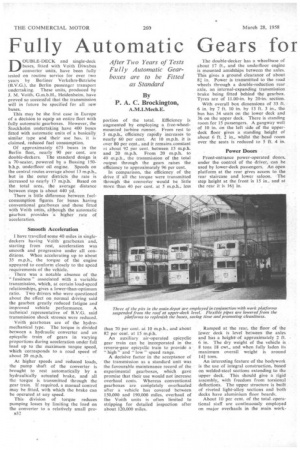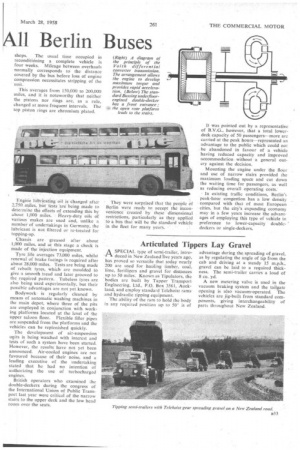Fully Automatic Gears for All Berlin Buses
Page 66

Page 67

If you've noticed an error in this article please click here to report it so we can fix it.
• After Two Years of Tests Fully Automatic Gearboxes are to be Fitted as Standard
By
I. A. C. Brockington, A.M.I.Mech.E. DOUBLE-DECK and single-deck buses, fitted with Voith Diwa bus converter units, have been fully tested on routine service for over two years by Berliner Verkehrs-Betriebe (B.V.G.), the Berlin passenger transport undertaking. These units, produced by J. M. Voith, G.m.b.H., Heidenheim, have proved so successful that the transmission will in future be specified for all new buses.
This may be the first case in Europe of a decision to equip an entire fleet with fully automatic gearboxes. However, the Stockholm undertaking have 400 buses fitted with automatic units of a basically similar type and their use has, it is claimed, reduced fuel 'consumption.
Of approximately 675 buses in the Berlin fleet, nearly 90 per cent, are double-deckers. The standard design is a 70-seater, powered by a Bussing 150b.h.p. underfloor oil engine. Speeds on the central routes average about 13 m.p.h., but in the outer districts the rate is increased to nearly 17. m:p.h. Based on the total area, the average distance. between stops is about 440 yd.
There is little difference between fuelconsumption figures for buses having conventional gearboxes and those fitted with Voith Units, although the automatic gearbox provides 'a higher rate of Acceleration.
Smooth Acceleration 1 have travelled some 40 miles in singledeckers having Voith gearboxes and, starting from rest, acceleration was smooth and progressive under all conditions. When accelerating up to about 35 m.p.h., the torque of the engine appeared to conform closely to the speed requirements of the vehicle.
There was a notable absence of the " fussiness " associated with a variable transmission, which, at certain load-speed relationships, gives a lower-than-optimum ratio. Two drivers who were questioned about the effect on .normal driving said the gearbox greatly reduced fatigue and improved vehicle performance. A technical ,representative of B.V.G. said transmission shock stresses were reduced.
Voith gearboxes are of the hydromechanical type. The torque is divided between a hydraulic converter and an epicyclic train of gears in varying proportions during acceleration under full load up to the maximum torque speed, which corresponds to a road speed of about 20 m.p.h.
At higher speeds and reduced loads, the pump shaft of the converter, is brought to rest automatically by a hydraulically actuated brake, and• all the torque is transmitted through the gear train. If required, a manual control may be fitted, with which the brake can be operated at any• speed.
This division of torque reduces pumping losses by limiting the load on the converter to a relatively small pro a32
portion of the total. Efficiency is augmented by employing a free-wheelmounted turbine runner. From rest to 5 m.p.h., efficiency rapidly increases to nearly 60 per cent. At 10 m.p.h. it is over 80 per cent., and it remains,constant :It about 92 per cent. between 15 m.p.h. and 20 m.p.h. From 20 m.p.h. to 40 m.p.h.. the transmission of the total output through the gears raises the efficiency to approximately 96 per cent.
In comparison, the efficiency of the drive .ii. all the torque were transmitted through the converter would be little more than 40 per cent. at 5 m.p.h., less
than 70 per cent. at 10 m.p.h., and about 82 per cent. at 15 m.p.h.
An auxiliary air-operated epicyclic gear train can be incorporated in the reverse-gear epicyclic train to provide a "
high" and " low " speed range.
A decisive factor in the acceptance of the transmission as a standard unit was the favourable maintenance record of the experimental gearboxes, which gave promise that their use would not increase overhaul costs. Whereas conventional gearboxes are coMpletely overhauled after a vehicle has covered between 150,000 and 190.000 miles, overhaul of the Voith units is often limited to stripping for detailed inspection after about 120,000 miles.
The double-decker has a wheelbase of about 17 ft., and the underfloor engine is mounted amidships between the axles, This gives a ground clearance of about 82 in. Power is transmitted to the road wheels through a double-reduction rear axle, an internal-expanding transmission brake being fitted behind the gearbox. Tyres are of 11.00-in. by 20-in. section.
With overall box dimensions of 33 ft. 6 in. by 7 ft. 10 in. by 13 ft. 3 in., the bus has 34 seats on the lower deck and 36 on the upper deck. There is standing room for 15 passengers. A gangway well of 10 in. on the left side of the upperdeck floor gives a standing height of about 6 ft. 2 in., whilst the head room over the seats is reduced to 5 ft. 4 in.
Power Doors
Front-entrance power-operated doors, under the control of the driver, can be used by lower-deck passengers. An open platform at the rear gives access to the rear staircase and lower saloon. The step height at the front is 15 in., and at the rear it is 16+ in.
Ramped at the rear, the floor of the lower deck is level between the axles and has a height of approximately 2 ft. 6 in. The dry weight of the vehicle is 8 tons 18 cwt., and when fully laden its maximum overall weight is around 141 tons.
An interesting feature of the bodywork is the use of integral construction, based on welded-steel sections extending to the upper deck. This should give a rigid assembly, with freedom from torsional deflections. The upper structure is built of riveted light-alloy sections and both decks have aluminium floor boards.
About 10 per cent, of the total, operational staff are continuously employed on major overhauls in the main work shops. The usual time occupied in reconditioning a complete vehicle is four weeks. Mileage between :overhauls normally corresponds to the distance covered by the bus before loss of engine compression necessitates stripping of the unit.
This averages from 150,000 to 200,000 miles, and it is noteworthy that neither the pistons not rings are, as a rule, changed at more frequent intervals. The top piston rings are chromium plated.
f.ngine hibricating'oil is changed after 2,750 miles, .but tests 'are being made to determine the effects of extending this by about 1,000 miles. Heavy-duty oils of various makes are used and, unlike a number of undertakings in Germany, the lubricant is not filtered or re-treated for topping-up.
Chassis are greased after about 1,000 miles, and at this stage a check is made of the injection equipment.
Tyre life averages 73,000 miles, whilst renewal of brake facings is required after about 28,000 miles. Tests are being made of rebuilt tyres, which are moulded to give a smooth tread and later grooved to the required pattern. Tubeless tyres are also being used experimentally, but their possible advantages are not yet known.
Bodyworkis regularly cleaned by means of automatic washing machines in the main depot, where three of the pits are employed in conjunction with working platforms located at the level of the upper saloon floor. Flexible filler pipes are suspended from the platforms and the vehicles can be replenished quickly.
The development of air-suspension waits is being watched with interest and tests of such a system have been started. However, the results have not yet been announced. Air-cooled engines are not favoured because of their noise, and a leading executive of the undertaking stated that he had no intention ol' authorizing the use of turbocharged engines.
British operators who examined the double-deckers during the congress of the International Union of Public Transport last year were critical of the narrow stairs to the upper deck and the low head room over the seats. They were surprised that the people of Berlin were ready to accept the inconvenience created by these dimensional restrictions, particularly as they applied to a bus that will be the standard vehicle in the fleet for many years. It was pointed out by a representative of B.V.G., however, that a total lowerdeck capacity of 50 passengers—more are carried at the peak hours—represented an advantage to the public which could not be abandoned in favour of a vehicle having reduced capacity and improved accommodation without a general outcry against the decision.
Mounting the engine under the floor and use of narrow stairs provided he maximum loading space and cut down the waiting time for passengers, as well as reducing overall operating costs. In existing traffic conditions, Berlin's peak-hour congestion has a low density _ compared with that of most European cities, but the city's expanding economy may in a few years increase the advantages of employing this type of vehicle in preference to lower-capacity doubledeckers Or single-deckers.




















































































































